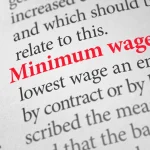As we go into the 2022-23 tax year, it’s a good time to look at what’s changed for payroll for the coming year. The usual adjustments are to national minimum wage, tax codes and thresholds for national insurance. I’ve covered these topics below, along with a couple of new deductions that the Government have introduced for this year.
National Minimum Wage
The national minimum wage increased from the 1st April 2022. Whether an employee is paid an hourly rate or a salary, their gross pay must reflect their hours worked at national minimum wage.
| National Minimum Wage Rates | 2021-22 | 2022-23 |
| Aged 23 and above (national living wage rate) | £8.91 | £9.50 |
| Aged 21 to 22 inclusive | £8.36 | £9.18 |
| Aged 18 to 20 inclusive | £6.56 | £6.83 |
| Aged under 18 (but above compulsory school leaving age) | £4.62 | £4.81 |
| Apprentices aged under 19 | £4.30 | £4.81 |
Tax Code Uplift and Tax Thresholds
The first thing to notice is that unusually this year there is no tax code uplift. In everyday terms, this means that there is no increase in an employee’s non-taxable allowance for the year. The basic tax code in 2021-22 was 1257L and it remains the same this year.
In England and Wales, the thresholds that 40% tax deductions begin also remain at £37,701.00 with the 45% rate remaining at £150,000.00.
In Scotland, the 19% threshold has increased from £2,097.00 to £2,162.00, and the 20% has increased from £12,726.00 to £13,118.00. The 21%, 41% and 46% thresholds remain the same.
National Insurance and the new Health and Social Care Levy
An additional 1.25% has been added to national insurance this year, for both employers and employees due to the Health and Social Care Levy introduced by the Government. This means that employees will now see a deduction of 13.25% on earnings rather than the 12% in 2021-22. Employers’ national insurance rate increases from 13.8% in 2021-22 to 15.05% for 2022-23.
To counteract this earnings squeeze for employees, the earnings thresholds that national insurance is deducted from has increased. In real terms, employees had NI deducted on earnings above £797.00 per month in 2021-22. In 2022-23, employee NI will be deducted on earnings over £823.00 per month.
Employers are benefitting from a similar increase with employer NI payable on earnings over £758.00 rather than £737.00 per month.
The upper earnings threshold is the point at which the deduction percentage reduces to 2% for employees. This remains at £4,189.00 per month in line with 2021-22.
Employers NI for Employers in a Freeport Location
The government have created 8 ‘Freeport’ locations within the UK (which will increase to 11 with the addition of one in Wales, Scotland and Northern Ireland in the future). Any employer in a Freeport location will only contribute employers NI on qualifying employees’ earnings above the new Freeport Upper Secondary Threshold of £25,000.00 at 13.8% rather than the new rate of £15.05%. Employer NI below this threshold is at 0%. The employee will also benefit by paying NI at a rate of 12% on earnings over £797.00 per month rather than the new 13.25%. There are further qualifying rules around Freeport and here are some links to useful HMRC website pages about freeports and Employers NI relief.
Employers Allowance
Employers allowance is a relief that can be claimed against employers NI, and is processed through payroll submissions to HMRC each pay period.
For employers that are entitled to claim, Employers Allowance has increased from £4,000.00 to £5,000.00 this year.
Statutory Payments
Statutory Sick Pay
At the point of writing, the Covid SSP Scheme ceased from March 2022. SSP must be paid to employees who are absent, whether due to Covid or another reason. The rules and eligibility for SSP for absences are now the same regardless of the reason for the absence.
SSP has increased from £96.35 per week in 2021-22 to £99.35 per week in 2022-23.
Statutory Maternity Pay (SMP) and Other Parental Leave Payments
The rules around entitlement have not changed, so where entitlement to a 90% payment of average weekly earnings is due this remains the same. The lower threshold rate of payment, being £151.97 from 2021-22 has increased to £156.66.
Student Loans
The student loan repayment percentage of 9% (and 6% for post graduate loans) remains the same this year. There has been a small increase in some of the thresholds that payments start at.
| Plan Type | 2021-22 | 2022-23 |
| Plan 1 | £1,657.91pm | £1,682.91pm |
| Plan 2 | £2,274.58pm | £2,274.58pm |
| Plan 4 | £2,083.33pm | £2,114.58pm |
| Post-graduate Loan | £1,750.00pm | £1,750.00pm |
Auto Enrolment Workplace Pension Contributions and Thresholds
There is no change around the thresholds and percentages this year. Employees still need to be enrolled in a scheme when their gross earnings are £10,000.00 per year or more. This is assessed at each pay period, so in real terms employees must still be enrolled when their earnings are £833.00 per month or more. Contributions are calculated on earnings over £520.00 per month and are a minimum of 5% for employees and 3% for employers.
Employees are feeling a financial squeeze in many ways, so let’s do a quick comparison for both the employee and the total cost for the employer. Let’s look at two different scenarios.
Firstly, an employee earning £14,000.00 per year or £1,166.67 per month. Starting with some good news their tax deduction does not change. Based on a standard tax code of 1257L the employee’s deduction is £23.83.
The employees’ NI percentage has increased from 12% to 13.5%, but the earnings threshold where NI is deducted has increased. Employee NI deduction in 2021-22 was £44.36, whereas in 2022-23 this increases to £45.54.
The employee pension contribution does not change, at £32.33.
The effect of this is felt by the employee as a reduction in take home pay of £1.18.
Employer NI costs for 2022-23 are £61.50, increased from £59.29 in 2021-22, with employer pension contributions being the same at £19.40.
Total monthly pay bill cost for the employer in 2021-22 was £1,245.36 increasing to £1,247.57, an increase of £2.21.
Now let’s take a look at a higher earner. Based on an employee earning £28,000.00 per year or £2,333.33 per month, and a standard tax code of 1257L the employee’s deduction is £257.17.
Employee NI deduction in 2021-22 was £184.36, whereas in 2022-23 this increases to £200.12.
The employee pension contribution does not change, at £90.67.
The effect of this is felt by the employee as a reduction in take home pay of £15.76.
Employer NI costs for 2022-23 are £237.09, increased from £220.29 in 2021-22, with employer pension contributions being the same at £54.40.
Total monthly cost for the employer in 2021-22 was £2,608.03 increasing to £2,624.82, an increase of £16.79.
In summary, whilst the employer is finding an increase in pay bill costs at all salary levels, employees are feeling the pinch more acutely due to the increase in NI because of the new Health and Social Care Levy. Whilst there is a significant increase in hourly rate in comparison to previous years, if an employee is already above the national minimum wage threshold an employer may not increase an employee’s rate, leaving them to earn less in real terms as the cost-of-living increases.
From a payroll perspective there are no answers to any of this, but ensuring employers and employees have clear knowledge of their deductions is important.
If you have any questions relating to national minimum wage, tax and NI, or the new Health and Social Care Levy or Freeport, please pick up the phone. The office is open from 9am to 5pm Monday to Friday and Nadine is always happy to help.





